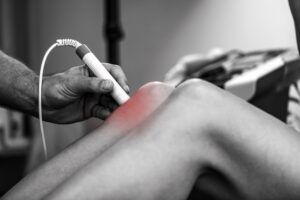Knee ligament injuries are among the most common and serious musculoskeletal injuries, often occurring during athletic activity or as a result of trauma. The knee joint relies on four primary ligaments for stability: the anterior cruciate ligament (ACL), posterior cruciate ligament (PCL), medial collateral ligament (MCL), and lateral collateral ligament (LCL). Each plays a specific role in maintaining proper joint movement and alignment. When any of these ligaments are sprained or torn, it can lead to significant pain, instability, and a loss of mobility.
These injuries can range in severity from mild sprains to complete tears. ACL injuries are especially prevalent in sports involving pivoting or sudden stops, such as soccer or basketball. PCL injuries usually result from a direct blow to the front of the knee, while MCL and LCL injuries are often caused by force to the side of the knee. Accurate diagnosis is critical, as treatment options vary depending on which ligament is affected and the extent of the injury.
Diagnosing Ligament Damage and Determining Severity
Proper diagnosis begins with a thorough physical examination and a detailed review of how the injury occurred. Swelling, instability, and pain in specific areas of the knee help indicate which ligament might be involved. Imaging studies such as X-rays or MRIs are often used to assess soft tissue damage and determine the grade of injury. Ligament injuries are typically graded on a scale:
- Grade 1: Mild sprain with microscopic tearing
- Grade 2: Moderate sprain with partial tearing
- Grade 3: Complete tear of the ligament
Understanding the grade and location of the injury helps determine whether surgical or non-surgical treatment is most appropriate. At Premier Orthopaedics & Sports Medicine, P.C., with locations in Bloomfield, Englewood, and Union City, NJ, our orthopedic specialists use advanced diagnostics to guide each patient’s personalized care plan.
Non-Surgical Treatment Options
Conservative Approaches for Healing
Not all ligament injuries require surgery. Many Grade 1 and some Grade 2 injuries can be effectively managed through non-surgical treatments. Rest, ice, compression, and elevation (RICE) are often recommended immediately following the injury to reduce swelling and inflammation. Bracing may also be used to stabilize the joint and protect the ligament during the healing process.
Physical therapy is a cornerstone of non-surgical recovery. Therapists work with patients to strengthen surrounding muscles, restore flexibility, and improve joint function. A gradual return to activity is encouraged under close medical supervision. Non-surgical care is especially effective for MCL and LCL injuries, which often respond well to conservative treatment if diagnosed early and managed appropriately.
Medication and Activity Modification
Anti-inflammatory medications like ibuprofen can help control pain and swelling during the initial phase of recovery. Activity modification is also key—patients are advised to avoid movements that put strain on the injured ligament. For athletes or active individuals, cross-training and low-impact exercises may be recommended as a temporary alternative to avoid regression during healing.
When Surgery Becomes Necessary
Indications for Surgical Repair or Reconstruction
Surgery is often necessary for complete (Grade 3) tears, particularly in the ACL and PCL. These ligaments do not heal well on their own due to limited blood supply and the functional demands placed on them. Reconstructive surgery is typically performed using a graft taken from the patient’s own tendon (autograft) or a donor (allograft), which replaces the torn ligament.
Surgical intervention is usually recommended when:
- The knee is unstable and gives way during daily activities
- The patient is young and wishes to return to high-level sports
- Non-surgical treatments have failed to relieve symptoms
- Multiple ligaments are injured simultaneously
At Premier Orthopaedics & Sports Medicine, P.C., our orthopedic surgeons specialize in minimally invasive arthroscopic techniques that promote faster recovery, less scarring, and reduced post-operative discomfort.
Post-Surgical Rehabilitation
Rehabilitation following knee ligament surgery is vital to a successful outcome. Physical therapy typically begins within days of surgery and focuses on restoring range of motion, rebuilding strength, and retraining balance and coordination. The rehabilitation timeline varies depending on the ligament and surgical technique, but most patients require several months to achieve full recovery.
Patients are closely monitored throughout the rehab process to ensure proper healing and avoid complications. Commitment to physical therapy, along with regular follow-ups, is essential to achieving the best long-term outcomes. Most patients can return to sports or physically demanding activities within 6 to 12 months, depending on their progress and individual goals.
Choosing the Right Treatment Path
Deciding between surgical and non-surgical treatment for a knee ligament injury depends on several factors, including the type of ligament affected, severity of the tear, lifestyle demands, and overall health of the patient. While surgery offers the possibility of full functional restoration for certain injuries, non-surgical approaches can be highly effective for others. The key is a comprehensive evaluation and shared decision-making between patient and physician.
Premier Orthopaedics & Sports Medicine, P.C. provides expert diagnosis, advanced treatment options, and personalized care for patients in Bloomfield, Englewood, and Union City, NJ. Whether you’re an athlete looking to return to peak performance or simply hoping to walk without pain, our team is here to guide you every step of the way toward recovery.
Sources
Logerstedt, D., Grindem, H., Lynch, A., et al. (2017). Return to Sport After ACL Injury: Clinical Practice Guidelines. Journal of Orthopaedic & Sports Physical Therapy.
Shelbourne, K. D., & Gray, T. (2000). Minimum 10-Year Results After Anterior Cruciate Ligament Reconstruction. Clinical Orthopaedics and Related Research.
LaPrade, R. F., Bernhardson, A. S., Griffith, C. J., et al. (2010). Posterior Cruciate Ligament Anatomy and Biomechanics. The American Journal of Sports Medicine.




